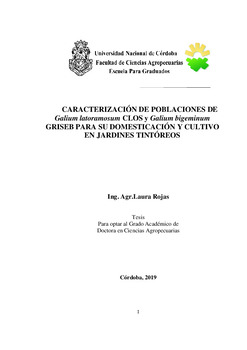| dc.contributor.advisor | Joseau, Marisa Jacqueline | |
| dc.contributor.author | Rojas, Laura María Gloria | |
| dc.date.accessioned | 2020-12-01T01:02:07Z | |
| dc.date.available | 2020-12-01T01:02:07Z | |
| dc.date.issued | 2019 | |
| dc.identifier.uri | http://hdl.handle.net/11086/16982 | |
| dc.description | Tesis (Doctor en Ciencias Agropecuarias) -- UNC- Facultad de Ciencias Agropecuarias, 2019 | es |
| dc.description.abstract | El objetivo de esta tesis fue caracterizar morfológica y químicamente poblaciones de Galium spp. para su domesticación en jardines tintóreos. El material de trabajo fueron dos especies del género Galium: G. latoramosum Clos y G. bigeminum Griseb. Se caracterizaron morfológicamente las plantas madres de crecimiento espontáneo y su descendencia, en condiciones de vivero, de 3 poblaciones de G. latoramosum y 3 de G. bigeminum. Se evaluó la capacidad tintórea y caracterización colorimétrica de las tres especies abordadas. Se estimó el rendimiento y calidad del órgano tintóreo en cultivo a campo y en condiciones controladas para G. latoramosum y G. bigeminum. Se ajustó un método de tinción para evaluar la calidad de tinción para las tres especies. Se determinaron los compuestos químicos con propiedades tintóreas sólo para G latoramosum y con la finalidad de iniciar su domestición se efectuaron estudios morfoanatómicos, de ruptura de dormición de las semillas de las poblaciones de crecimiento espontáneo y registros de estadios fenológicos en condiciones de cultivo, además de evaluar su comportamiento bajo 3 niveles de sombreo en vivero y frente a la multiplicación in vitro. Se concluye que las poblaciones espóntaneas de G. latoramosum y G. bigeminum se diferencian en su caracterización morfológica y colorimetrica. La diferenciación solo se manifiesta en la descendencia de G. latoramosum a nivel morfológico pero no a nivel colorimetrico. Es posible producir plantas de G. latoramosum por semillas pretratadas con peróxido de hidrógeno al 40 % por una hora para ruptura de dormición y obtener 60% PG. También obtener altas tasas de multiplicación por rizomas in vitro. Para cultivarla en jardines tintóreos necesitan un sombreo del 30 % para obtener mayor crecimiento y supervivencia. G. latoramosum produce en cultivo de 2 años raíces con un peso fresco de 4 g y un rendimiento del 45% de peso seco siendo estos tintes de buena solidez a la luz y al lavado. Galium bigeminum presento mayor producción de raíces con un rendimiento medio de 21g de PFPR, pero con 20% de materia seca. | es |
| dc.description.abstract | The objective of this thesis was to characterize wild populations of Galium spp for its domestication and culture in dyeing gardens. The working material were two species of the
Galium genus: G. latoramosum Clos and G. bigeminum Griseb. The spontaneously
growing mother plants and their offspring were characterized morphologically under
controlled conditions of 3 populations of G. latoramosum and 3 of G. bigeminum. The
dyeing capacity and colorimetric characterization of the three species studied were
evaluated. The yield and quality of the dye organ were estimated in field culture and in
controlled conditions for G. latoramosum and G. bigeminum. A staining method was
adjusted to evaluate the staining quality for the three species. The chemical compounds
with dyeing properties were determined only for G latoramosum and in order to start their
domestication, morphoanatomical studies were carried out, as well as the dormant rupture
of the seeds of the spontaneously growing populations and records of phenological stages
under culture conditions. Evaluate their behavior under 3 levels of nursery shade and in
vitro multiplication. It is concluded that the spontaneous populations of G. latoramosum
and G. bigeminum differ in their morphological and colorimetric characterization. The
differentiation only manifests itself in the offspring of G. latoramosum at the
morphological level but not at the colorimetric level. It is possible to produce plants of G.
latoramosum by seeds pretreated with 40% hydrogen peroxide for one hour to break
dormancy and obtain 60% PG. Also obtain high rates of multiplication by in vitro
rhizomes. To grow it in tintóreos gardens they need a shade of 30% to obtain greater
growth and survival. G. latoramosum produces 2-year-old roots with a fresh weight of 4 g
and a yield of 45% of dry weight, these dyes being good in light fastness and washing.
Galium bigeminum showed higher root production with an average yield of 21g of PFPR,
but with 20% of dry matter. | en |
| dc.format.extent | 193 h. : ilustraciones, mapas, fotografías, tablas, gráficos color | es |
| dc.language.iso | spa | es |
| dc.rights | Attribution-NonCommercial-NoDerivatives 4.0 Internacional | * |
| dc.rights.uri | http://creativecommons.org/licenses/by-nc-nd/4.0/ | * |
| dc.subject | Plantas tintóreas | es |
| dc.subject | Características morfológicas | es |
| dc.subject | Propiedades químicas | es |
| dc.subject | Cultivo | es |
| dc.subject | Pigmentos | es |
| dc.subject | Reproducción asexual | es |
| dc.subject | Reproducción sexual | es |
| dc.title | Caracterización de poblaciones de Galium latoramosum Clos y Galium bigeminum Griseb para su domesticación y cultivo en jardines tintóreos | es |
| dc.type | doctoralThesis | es |
| dc.description.fil | Fil: Rojas, Laura María Gloria. Universidad Nacional de Córdoba. Facultad de Ciencias Agropecuarias; Argentina. | es |
| dc.description.fil | Fil: Joseau, Marisa Jacqueline. Universidad Nacional de Córdoba. Facultad de Ciencias Agropecuarias; Argentina. | es |





